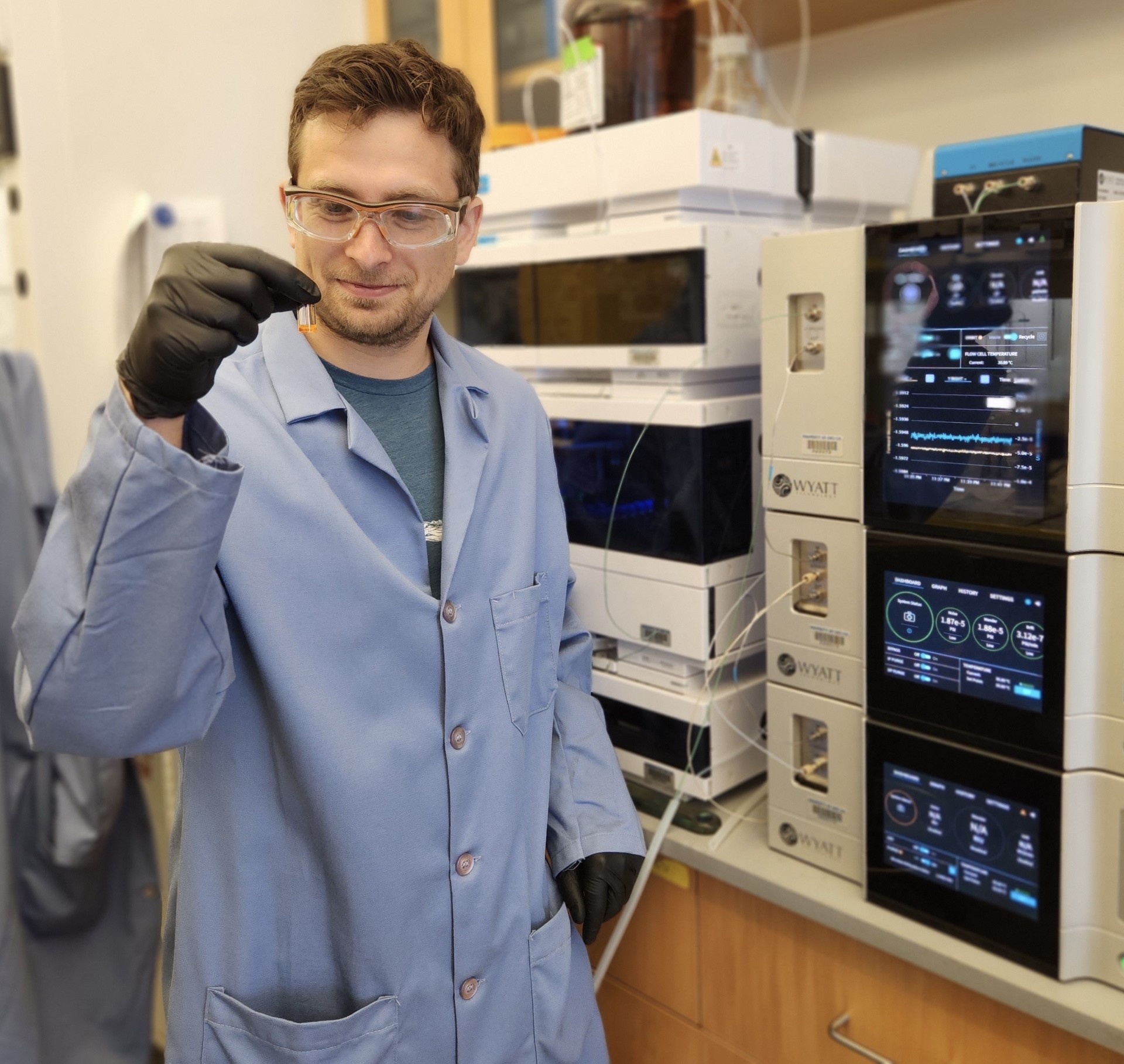Novel Method for Modifying Polymers Holds Promise for Innovation in Materials Design

Aleksandr Zhukhovitskiy holds a polymer solution sample for gel permeation chromatography. Photo by Rachael Ditzler
June 14, 2024 | By Dave DeFusco
Researchers from UNC Chemistry Department and the University of Minnesota have introduced a novel method to alter the structure of polymers after they’ve been produced without changing their chemical composition, according to their paper, “Architectural Editing of Polyesters and Polyurethanes via Palladium(II)-Catalyzed [3,3]-Sigmatropic Oxo-Rearrangements” in the Journal of the American Chemical Society.
This new technique holds significant promise for enhancing the properties of polymers, which are the basis of many modern materials and essential in numerous industrial applications. Polymers derive much of their functionality from their structural configuration. High-density polyethylene (HDPE), for example, has a linear structure, while linear low-density polyethylene (LLDPE) contains short branches. These structural differences affect how these materials react to heat, mechanical stress and other physical forces.
“Traditionally, once polymers are synthesized, their architecture is considered immutable,” said Rachael Ditzler, lead author of the paper and a Ph.D. student in chemistry at UNC-Chapel Hill. “However, this new method challenges that notion, offering a way to transform these structures and thereby tailor the material properties to specific needs.”
The researchers focused on a chemical reaction known as the [3,3]-sigmatropic oxo-rearrangement (SOR), which was first identified in the 1960s. This reaction, using palladium(II) salts as catalysts, rearranges the polymer backbone, effectively converting branched polymers into linear ones, or vice versa, under thermodynamic control. Unlike traditional methods that require new catalysts or combinations of monomers, this innovative approach requires only a single catalyst.
“The process is analogous to morphing spaghetti into rotini after the pasta’s been cooked,” said Aleksandr Zhukhovitskiy, a corresponding author of the paper, William R. Kenan, Jr. Fellow and assistant professor of chemistry at UNC-Chapel Hill.
This method also was effective with two types of polyesters (PE1 and PE2) and two types of polyurethanes (PU1 and PU2). The palladium(II)-catalyzed reaction converted these polymers from branched to linear structures without breaking the polymer chains, thus maintaining their essential properties while achieving desired structural changes.
“The generality of this reaction initially surprised us,” said Ian Tonks, a corresponding author of the paper and the Lloyd H. Reyerson professor of chemistry at the University of Minnesota. “Any polymer with a double bond in the right location could in principle undergo rearrangement. Now that we know what to look for, we are looking for similar patterns in other polymers that we can apply this strategy toward.”
Thermodynamic calculations, which aligned with the outcomes of their experiments, indicated that these materials react differently due to their varying levels of stability. For example, transforming one polyester from branched to linear lowered its glass transition temperature—a key parameter that helps determine how a material will behave under different temperature conditions—making it less rigid. Similar changes were observed in other tested polymers.
“This rearrangement also introduces a carbon-carbon double bond into the backbone, which gives us a good handle to break down the polymer using well-precedented strategies,” said Rachel Rapagnani, co-lead author on the manuscript and a Ph.D. student at the University of Minnesota.
Polyurethanes exhibited even more noticeable changes. Some types became insoluble, while others showed significant increases in toughness and flexibility, meaning they could bend more without breaking.
“This innovative method allows for precise adjustments to polymer structures, resulting in materials with tailored properties,” said Ditzler. “The ability to modify the architecture of polymers post-synthesis opens new avenues for materials design and application, offering a versatile tool for creating advanced materials suited to specific industrial needs.”
Potential applications of this method are vast, ranging from improving the durability and flexibility of materials used in construction and automotive industries to enhancing the recyclability of polymers, contributing to more sustainable materials management practices.
“As we continue to explore the capabilities and applications of this new technique,” said Zhukhovitskiy, “it is poised to expand the possibilities for innovation in materials design.”

